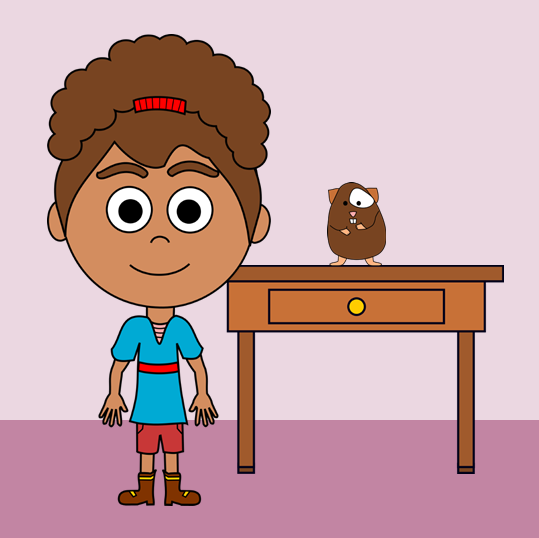 Considering keeping a class pet? Here are some things to think about before you make the decision to bring a live animal into your classroom.
Considering keeping a class pet? Here are some things to think about before you make the decision to bring a live animal into your classroom.
The pros of keeping a class pet
1. Your students will learn something about responsibility. You can rotate the feeding schedule of your class pet so that every day (or week), someone new is in charge of feeding your classroom friend. For an entire day or week, a single child could be fully in charge of the pet. They can perform a variety of tasks including feeding the pet, caring for the pet, and helping to clean the pet’s living space (depending on what sort of pet you keep).
2. Some students might not be allowed to have pets at home, and having a class pet will help them to experience something they would never have been able to experience without having a class pet. This will help them to experience new emotions, learn new skills, and understand the feeling of having a dependent.
3. You can bring math and science to life by keeping a class pet. Here’s an example of how you can make a unique math journal prompt for your class about your class pet: “If Chilly, our hamster, eats 30 pellets of food a day, how many pellets does he eat in one week?”
4. Students will learn about respect and commitment through helping to take care of their class pet. As they watch the pet grow and change they will see and understand the correlation between a pet and other living beings. This could help them to learn empathy and compassion.
The cons of keeping a class pet
1. Someone has to clean up after the pet! Even the cleanest pet will require some extra work from you or from the kids in your classroom (though the ultimate responsibility rests on you, the teacher.
2. The pet may die in your care, and if it does, you’ll have to console your students and explain to them the not-much-fun concept of death. Some may not see this con as a negative, however, as going through this unhappy experience will help your students to understand the cycle of life, and help them to cope with death when it occurs in their own private lives.
3. You’ll have to pay for food and equipment needed for your class pet. However, there do exist organizations, like Pets in the Classroom, that offer grants to help subsidize teachers and educational institutions to keep a pet in the classroom.
4. You’ll have to take it home on weekends and holidays and care for your class pet in between school days, or find someone else who can do this for you.
5. Some of the children in your class might have allergies, and might be allergic to certain pets. Children can be allergic to hamsters or gerbils, for example. this is something that would have to be taken into account if you are going to have your class care for a furred class pet.
Alternatives to a class pet
If you’re not quite ready to purchase and keep a pet in your classroom, there are some ways that your students can experience what it is like to have a class pet without undergoing the full experience. Here are some viable alternatives:
1. Borrow a neighbor’s pet for the week and allow your students to experience caring for it for a short period of time. You might even bring in a different friend’s pet each week: an iguana, a bunny, fish, a dog, and so on. You can then tie your science and math lessons to the new pet that is visiting your classroom for the week. Using this method, the students can learn a lot about a lot of different pets during a school semester or term.
2. You can ask a pet store if they would let you undergo a trial period with one of their pets to see if keeping it might work out in your classroom. This would give you an opportunity to see if you and your students want or are ready to make the full commitment to keeping a pet in your classroom.
3. They may not be as fun as class pets, but keeping plants in the classroom can also help students learn about caring for living creatures, proper food and nutrition, and the cycle of life, death and rebirth through growing new plants from seeds harvested from older plants.
Types of pets that make good class pets
Qualities of a good class pet are: cheap, small and hardy!
Examples of some good choices for class pets:
- Hamsters, gerbils and guinea pigs make great pets because they are soft, furry and funny, especially if you buy a running wheel for them to exercise on. Kids love to watch them at play!
- Fish are also great, especially Betta fish, as they require less cleaning of their environments and are a very hardy fish. Just remember not to keep more than one Betta fish in a single aquarium at one time! They aren’t called Siamese Fighting Fish without good reason.
- Reptiles also make great class pets, but make sure to get one that is not poisonous and does not require a very specific environment that needs to be regulated with care. It is important to find a pet that is simple and fun to take care of.
Best of luck with making your decision whether or not you and your students should make the commitment to keep a class pet! If you do decide to keep a pet in your classroom, I hope that you and your students enjoy and benefit from caring for it.




This is a great list of pros and cons! Thank you for including Pets in the Classroom in the post. Class pets have wonderful benefits if a teacher is ready to handle the extra responsibility and learn how to care for the pet properly.
Hello Rachel, thanks for the kind feedback – I appreciate it! I agree that the responsibility and care of the classroom pet (and the safety of the students) is of utmost importance.
I will check out your site to learn more about keeping pets in the classroom. Thanks again, and all the best to you in your work with the Pet Care Trust!
I really liked it to and I will use this website for my persuasive essay. Thank you!
I am happy to hear it – thanks very much! Best of luck on your essay.
Me to I’m working on a school project
And it’s relly helping me
I love this so much. Thx
same but i think it is bad
I disagree with you because what if there are kids who are allergic to animals
This is a good article that all people should listen to:)
hi my name is lemon
I am an a preschool teacher and when our goldfish died, my class was upset. 6 weeks after the goldfish died is when every one got over it. KEEP PETS OUT OF THE CLASSROOM!
Hi there, I appreciate the counterpoint to this article! It is true that having a pet die can be traumatic to kids. Though it can also, depending on the age of the children, be a learning experience about life and death – one that they will eventually have to learn and come to grips with. It is up to the teacher and the parents to decide.
Thanks again for the comment!
I know that death is sad and all, but not all preschoolers are sad about it
True, death is a part of the life and death experience, and we all learn about it at some point. I appreciate the comment.
pets would show you responsibility
I love it!
Thank you so much! I am so glad that you like the article. Thanks for reading and for commenting!
Thank you so much. I am going to use this site for my essay!
I am really pleased to hear it. Thanks very much for letting me know! I hope that your essay turns out well.
I love the pros and cons on the website!😎 I’m using the info for my essay!!!
I am very pleased to hear that. Thank you very much! I hope your essay worked out for you, and that you enjoyed learning about the pros and cons of having pets in the school classroom.
thank you this helped me for my 5 pages for launguage art and i got a b+
Im using this for a persuasive essay Too!!!
I love this list! You’ve probably noticed that people are making a lot of essays and I am one of those people. Thank you for your great reasons….
Thanks very much! I really appreciate hearing it. I hope that your essay writing goes well!
my essay went ABSOLUTELY FABULOUS!!! Thank so VERY much for your wonderful ideas and information! I got an A on my essay so thank you so much for creating this webpage!!!!
Thank you so much for letting me know. I am really glad to hear it! And I’m glad that you got an A on your essay.
cool that helped
I’m happy to hear it – thanks very much!
I have persuasive essay and i’m doing it on this
I’m pleased to hear that the information in this article helped you to write your persuasive essay. Thanks very much for letting me know.
Cool. I will totally use this for my essay
I am pleased to hear it. Thanks for letting me know. I hope that your essay about pets in the classroom is a good one!
i am using this for a research project and i think there should definitely be something about kids that are allergic to pets, in the cons section 😉
That is a very good point. Thanks for the feedback! I will add something to the post.
I hope you are having a wonderful school year!
I am having a great school year!
this is exactly what im doing
This IS AMAZING It is sooo good and helpful and it will help me with my argumentative essay Thanks soo much for wrighting this .
🙂
Thank you so much for the kind feedback – I really appreciate it! I am pleased that the article was able to help you with your argumentative essay.
Thank you so much for all of these proas and cons. needed for my essay! Plus these facts are pretty serious. 🙂
You are very welcome! I am pleased that the various pros and cons helped you to write your essay. I hope it turned out well.
This site will be really useful for my pros of having a class pet persuasive essay!
I am glad to hear that. Thank you very much! All the best to you in your studies.
I’m against having a class pet because most of my sources have some more cons than pros… and (not everyone likes pets) I mean their cute and all but they are a lot of work need most of the attention and someone has to CLEAN UP after the pet.
Thank you for your feedback – I really appreciate it! I am glad to hear your opinion about having pets in the classroom.
Thanks for writting this it will help me for my essay.And i agree with everything you said….
You are very welcome! Thank you very much for the feedback. I am glad that you liked the post about pets in the classroom.
This is so helpful i learned a lot. This is very useful and you are a great author!!!
And yes im doing an essay too. I say Cons. No pets in the classroom!!!!
I am glad to hear that – thanks very much for your comment and for your opinion about pets in the classroom! I appreciate it. All the best to you and your middle school classmates this spring season.
I am happy to hear that you have learned some interesting information about pets in the classroom through this post. Thank you very much for letting me know – I really appreciate it!
thank you
I think that pets should be allowed in school class rooms because they would keep you strees
free and then you could be reminded of how we live in a boutfual world
good pros and cons for my argument essay
I am doing some reserch on classroom pets and was wondering if maby i could ask you a few questions about classroom pets thank you.
thank you
my question is are classroom pets good or bad and do you think class pets are good or bad
Pets should not be in classrooms because of emotional effects of one of there pets dying and pets are neglected over weekends/holidays and vacations and pets in classrooms get poor quality care.
true true but if someone were to stay there it would have better ways to turn out
same
NO PETS IN CLASSROOMS
im using this for my essay i think its amazing
you are right!!!!!!
Thank you so much! This really helped for my Class Pets Debate.
sup thank you for putting this website up ma’am or sir
Hey, so I am a 5th grader and in my class, we are working on why or why not we should have pets in the class and I think that we should not because of allergies. There is one thing that I love about this website and that is that there are pros and cons in why or why not schools should have animals in their classrooms.
Hey, I’m an 8th grader, and in my ELA class we are doing the same thing xD
I’m a 7th grader and I am doing the same thing we read a newsela too
same
yup same
Lol same here
I’m a 5th grader too and i had to do weather kids should have pets in class or not
That is a very good reason. Thanks for sharing that!
i hate green beans
me tooooo
This helps a lot. im using it for my essay
this is great it helped me write for a test
whos your publisher
???????,??????????! .
thank you im for class pets on my essay
I was looking around for an article about pets in the classroom to help my with my English arts essay. And I found this, the article itself is nice, but I couldn’t help but to frown when I read about the guinea pig in a ball. Although guinea pigs are rodents, they should never be put in plastic balls or running wheels because their backs are not designed to bend backward, and doing so can result in severe or permanent damage.
This article may be called Pro and cons of having a class pet, but I’m finding too much bias in here, and not digging deep enough into the cons. And the cons that are there aren’t that helpful.
To make the article better, I suggest to do more research.
hi there like hi i like this wedsite
No mention of the effects of classroom captivity on the animals themselves? It’s great that you will have “fun” keeping the animals, but what do they get out of it (besides being forced to live in a loud, inconsistent environment with spotty care and inexperienced handlers?) You should have delved a little deeper into that. Also, “make sure to get [a reptile] that… does not require a very specific environment that needs to be regulated with care”? ALL animals, and especially reptiles, have specific needs and habitats that need regulation. If you are looking for something that requires little to no effort, just get a plant. Animals are living beings, not props for you to decorate your classroom with so that once a week some kid can feel “responsible” for having poured a bowl of pellets.
Awesome pros but I don’t know about the cons.
This is a great way to teach children the responsibilities of keeping a school pet healthy an happy
Thank you this now I know the responsibilities of keeping a school pet.
do you guys notice the stalker in the window in the photo
hello
Me too this is great
today is my birthday
who asked
Used this as a source for my essay and helped with getting info to stick in loose spots! Very helpful and easy to take notes from!
ok..so im in 3rd grade and my teacher used to have a classpet. ive never seen it tho. but anywayz…i like this site and im gonna use this for my persusive writing!!!! (: hope u have a happy easter! love~kitten
im in third grade too and i say pets should be always never always allowed in the classrook snniajkss i love constnie
hey what class u in?
Brian! i have an idea! can you add a con about this? also im doing this for my persuasive writing and im only using the pros..but i for the other people. ”Guinea pigs might be cheap…but its hard work to care for them. A goldfish is cheap and interesting tho.”
constitene? like the one in my class?
I am definitely going to use this for my argumentative essay for school.
Thanks for information, i use that